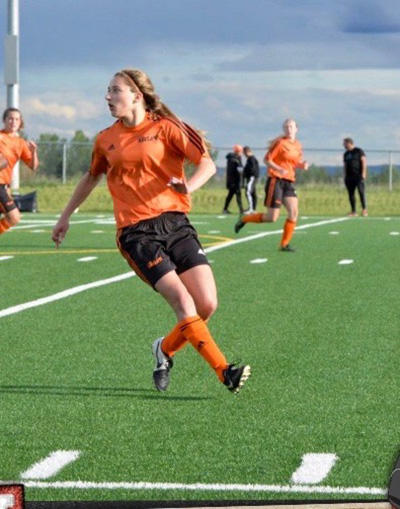Sept. 25, 2018
Kinesiology researcher fired up at prospect of reducing injuries in youth

High school student Rachel Cooper in a game at the Edge School, west of Calgary.
Rachelle Chrispen
When she heard a pop, then collapsed, Rachel Cooper immediately thought, “This is it.” Cooper had just returned from an elite soccer training camp in England, a pathway program for the Canadian national team. In her first game back in Canada, five minutes into the second half, she was bumped on her shoulder, twisted her knee and ended up with a torn ACL (anterior cruciate ligament) and meniscus.
“My heart shattered,” says Cooper, who was out of the sport she loved for 15 months. It was a tough lesson in injury prevention. Unfortunately, Cooper’s experience is not unique.
Youth at risk of injury
In Canada, unintentional injuries are the leading cause of disability in youth. One in three youth seek medical attention for a sport or recreational injury each year and four young people are hospitalized for an injury every day. Lower extremity injuries comprise more than 60 per cent of these injuries.
“Injuries are not accidents; they are predictable and preventable,” says Dr. Carolyn Emery, PT, PhD, chair of the Sport Injury Prevention Research Centre, Faculty of Kinesiology, University of Calgary. “The best treatment for youth sport and recreational injury is prevention.” Emery is also a full member of the Alberta Children’s Hospital Research Institute where she holds a Chair in Paediatric Rehabilitation, the O’Brien Institute for Public Health, and McCaig Institute for Bone and Joint Health, all at the Cumming School of Medicine.
New funding for Emery
Emery has received multi-year funding over $1 million from the Canadian Institutes of Health Research (CIHR), Foundation Grant to SHRed Injuries (Surveillance in High Schools to Reduce the risk of Injuries and their consequences in youth). This new program builds on a decade of research informing best practice and policy in injury prevention in youth sport. Highlights include evidence-informed policy led by Hockey Canada to eliminate body checking nationally for 11- and 12-year-old ice-hockey players (Peewee), which had a significant impact in reducing injuries and concussions.
Emery’s goal for this CIHR Foundation grant is to create and implement prevention programs to reduce the risk of lower extremity injuries in a variety of high-risk sports such as basketball, soccer, and rugby. Prevention programs could reduce the burden of lower-extremity sport-related injuries and consequences of injuries, including obesity, osteoarthritis, and reduced participation in sport.
The program will engage youth, parents, coaches, clinicians, sport organizations, educators, and policy-makers across health care, education, sport, and public health.
High school connection
“Research is important as it allows us to use the best possible teaching and strategies in schools to support the health and learning of students,” says Brian Torrance, director of Ever Active Schools. He is a community partner in the research program in Injury Prevention in Youth Sport and a partner in the CIHR Foundation grant. Ever Active Schools is an Alberta initiative designed to assist school communities in addressing and creating healthy school communities.
“School change occurs best when policy, teaching and learning, through professional development, strong partnerships and a supporting social and physical environment, are all in place,” says Torrance, referring to the knowledge translation that puts research into action.
Torrance has supported the implementation and evaluation of an injury prevention neuromuscular program in physical education in several Calgary junior high schools over the past three years in partnership with Emery and Alberta Program in Youth Sport and Recreational Injury Prevention. “Once the relationship and the understanding of the warm-up was in place, it was well received by teachers,” says Torrance.
Emery’s study will start in high schools in Alberta and then branch out to include schools nationally and in partnership with some Indigenous communities.
Athlete learning
Cooper, now 18, is back at the sport she loves as an athlete on the varsity soccer team at MacEwan University. She says she wished she knew more and did more to prevent her injury by training the muscles that would help stabilize her knee.
“I wish I listened to my body and not played in the game that day with calf issues and muscle fatigue,” she says.
Emery’s research program is supported by funds from the Canada Institutes of Health Research, the Vi Riddell Pediatric Pain Research Program and community donations though the Alberta Children’s Hospital Foundation.
